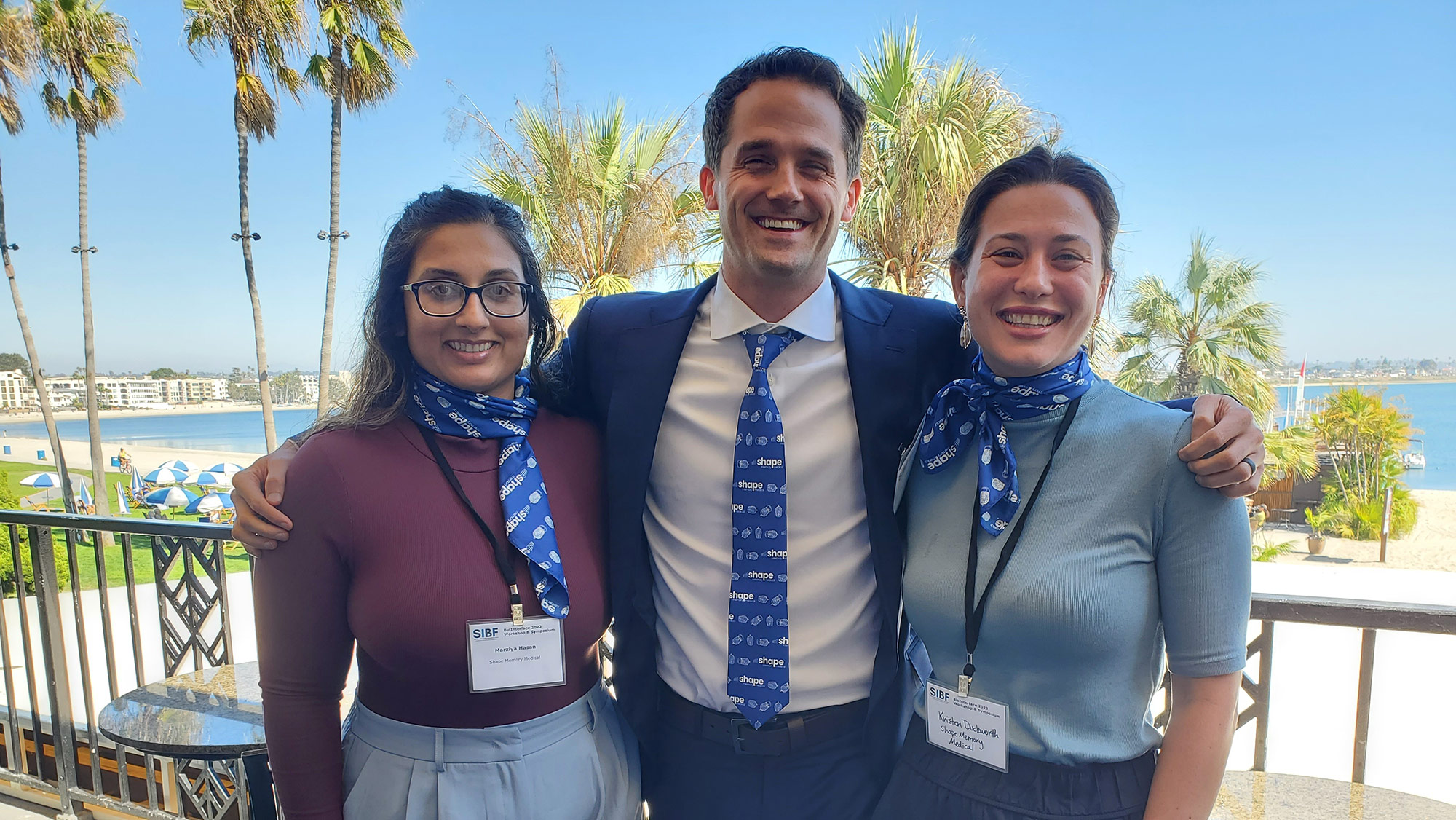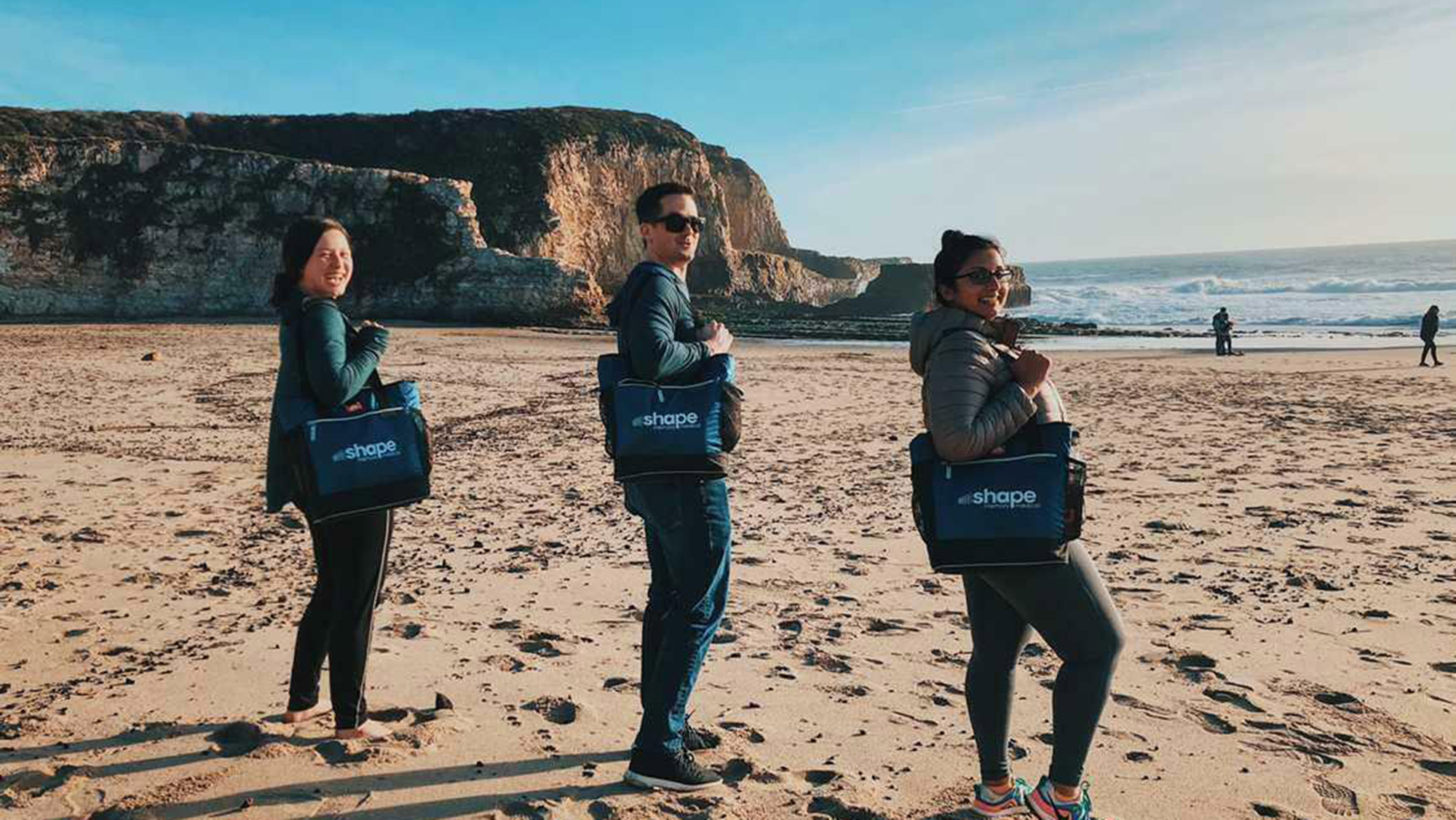
Three former Texas A&M University biomedical engineering graduate students have dedicated their careers to transforming a research idea into a full-fledged medical device company, Shape Memory Medical (SMM). For over a decade, Kristen Duckworth ’13 ’14, Dr. Marziya Hasan ’16, and Dr. Landon Nash ’12 ’17, have been advancing life-saving embolic devices for vascular conditions at SMM, building on technology developed in the lab of Dr. Duncan Maitland, the company’s co-founder.
Maitland, a senior professor in the Department of Biomedical Engineering, is responsible for creating the company's first embolic plug and shape memory polymer, a high-surface-area porous material that expands and conforms to the interior of a blood vessel. SMM’s embolic devices treat conditions like vascular aneurysms and pelvic venous disease.
"We develop devices intended to block off blood vessels causing harm," Maitland said. "SMM continues to study the use of shape memory polymer devices in other applications, including aortic aneurysms. The aorta — the body’s largest artery — can expand and weaken, posing a risk of fatal rupture. SMM has initiated a randomized controlled trial to continue to gather level one evidence for this application.”
Another of Maitland’s contributions to SMM is recruiting many of the founding research and staff members, including over 20 biomedical engineering former students he taught and mentored.
Kristen Duckworth
As a student, Duckworth felt unsure about her career path. After expressing uncertainty to her master’s advisor, former biomedical engineering faculty member Dr. Kristen Maitland, Duckworth was introduced to Dr. Duncan Maitland, the then director of the Texas A&M TEES Office of Commercialization and Entrepreneurship. This meeting would direct Duckworth to the career fulfillment she was searching for, first as an "entrepreneur in training" at TEES and then to SMM.
“A career in academia didn't quite feel like the fit for me, and I wasn't seeing where my next step would be,” she said. “I didn't know the answers. I didn't have this perfect vision. I just knew I wanted to work in medical devices. The Maitlands helped me take small steps in a direction that has been very fulfilling. The reason I am where I am today is because they took a chance on me.”
A few years into helping engineering researchers and professors find market applications for their technologies at TEES, Duckworth said she was ready to leave College Station for something new.
"Around that time, Shape Memory Medical was transitioning from an academic lab to more of a Silicon Valley established company with medical device veterans stepping in," Duckworth said. "Duncan helped set up an interview with the CEO, which went well, and I drove out to California to start my job there."
At SMM, Duckworth began her time as a project engineer, transitioned to quality engineer, and now works as a regulatory affairs specialist, obtaining and maintaining government approvals for the products. Although she no longer engineers products, Duckworth uses her biomedical engineering knowledge in day-to-day operations.
"Having a background in physiology and engineering allows for a deeper grasp of how our products function," she said. "Biomedical engineering gives you a unique understanding of the human body and the device-body interface, which helps me approach my work with more context and insight. That knowledge is invaluable in regulatory affairs."

Dr. Marziya Hasan
Drawn to Maitland's strong focus on commercialization, Hasan joined his lab as a graduate student and developed materials for specific biomedical applications. She said she never imagined being part of the team that would take these materials to market as biomedical devices.
"The technology has evolved so much from what we initially conceptualized in the lab," Hasan said. "Working in the industry feels like getting a second education, especially learning how commercialization operates in the real world versus in a lab environment. If I hadn't been in Dr. Maitland's lab, I wouldn't have been prepared for this kind of work environment.”
At SMM, Hasan manages a team of chemists and materials scientists, overseeing both manufacturing and research and development (R&D) projects. Her advice to biomedical engineering students — don't limit your options or feel confined by a specific path and learn from those already in professional spaces.
"I'd recommend connecting with people in the field, perhaps through the commercialization office or professors focused on this area," Hasan said. "Having a mentor who can guide you is crucial; it's much easier to learn with someone's guidance than to enter the job market and feel lost. Stay curious, seek out environments that value commercialization and build that experience early on."
Dr. Landon Nash
As an undergraduate student, Nash said Maitland convinced him that the department’s industry and translational focus would provide the best opportunities for his career. Maitland’s guidance led Nash to join his lab.
“He was right; Texas A&M’s unique environment allowed me to gain invaluable industry experience while still a student,” he said. “I was involved in patent licensing and collaborated with the Tech Transfer office, which was rare for a student. Those skills set me up for success and are things I wouldn’t have learned anywhere else.”
Nash is director of R&D and Strategic Partnerships at SMM. He said his most considerable contribution to the company has been managing the patent portfolio. He is named on about 40% of the patents and has helped obtain 95%. Initially on a pre-med track, Nash said seeing products go from concept to clinic fulfills his goal of helping patients.
"I chose biomedical engineering because I wanted to help people, and even though I didn't go into medicine, I still contribute to patient care by developing tools that clinicians use," Nash said. "I remember working on our neurovascular product as a student, mapping out regulatory hurdles and navigating preclinical testing. Now, I've seen that product help real patients."
He said working with Duckworth and Hasam allowed all three to lean on each other during the early stages of their careers, and they continue to support each other today.
“We all moved to California around the same time, and we even lived in the same house for about six months,” he said. “Working at a startup is intense, and that experience bonded us even more. We’re very close.”
The Future of SMM
SMM has product lines cleared for use globally, including four cleared in Europe and two in the United States. A large randomized, controlled, clinical trial — called AAA-SHAPE — is underway through the FDA with 180 patients, with parallel clinical trials happening in Europe.
“I’m really excited to see where the company goes over the next few years,” Hasan said. “We started as a small team in California in 2016, operating on a small scale. Since then, we’ve moved to a new facility and grown to over 50 people, and I think we’re going to continue expanding. I look forward to seeing how the company evolves and how my role grows along with it.”